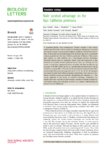1 - 25 of 9
| Creator | Title | Description | Subject | Date | ||
|---|---|---|---|---|---|---|
| 1 |
 |
O'Rourke, Dennis H. | Ascertainment bias for non-twin relatives in twin proband studies | When families are ascertained through affected twins, as for example when twin probands are selected from a registry and their non-twin relatives studied, a correction for ascertainment bias is needed. It is shown that probandwise counting (where relatives of doubly ascertained twin pairs are counte... | Genetic; Transmission; Models | 1982 |
| 2 |
 |
Rogers, Alan R.; Jorde, Lynn B. | Genetic structure of the Utah Mormons: comparison of results based on RFLPs, blood groups, migration matrices, isonymy, and pedigrees | The genetic structure of the Utah Mormon population is examined using 25 blood group and 47 RFLP alleles obtained from 442 subjects living in 8 geographic subdivisions. Nei's Gst was 0.013 (p < 0.002) for the RFLP data and 0.012 (p > 0.4) for the blood group data, showing that only 1% of the geneti... | 1994 | |
| 3 |
 |
Cashdan, Elizabeth A. | Waist-to hip ratio across cultures: trade-offs between androgen-and estrogen-dependent traits | A gynoid pattern of fat distribution, with small waist and large hips (low waist-to-hip ratio, or WHR) holds significant fitness benefits for women: women with a low WHR of about 0.7 are more fecund, are less prone to chronic disease, and (in most cultures) are considered more attractive. Why, then... | Fertility; Optimum; Fecundity | 2008 |
| 4 |
 |
Cashdan, Elizabeth A. | Waist-to-hip ratio across cultures: trade-offs between androgen- and estrogen-dependent traits | A gynoid pattern of fat distribution, with small waist and large hips (low waist-to-hip ratio, or WHR) holds significant fitness benefits for women: women with a low WHR of about 0.7 are more fecund, are less prone to chronic disease, and (in most cultures) are considered more attractive. Why, then... | Fat distribution; Gynoid pattern; Body types; Waist-to-hip ratio; WHR | 2008 |
| 5 |
 |
Macfarlan, Shane | Male Survival Advantage on the Baja California Peninsula | A consistent finding from contemporary Western societies is that women outlive men. However, what is unclear is whether sex differences in survival are constant across varying socio-ecological conditions. We test the universality of the female survival advantage with mortality data from a nineteenth... | ecology; health and disease and epidemiology; behaviour | 2020 |
| 6 |
 |
O'Rourke, Dennis H. | Patterns of genetic variation in native America | Allele frequencies from seven polymorphic red cell antigen loci (ABO, Rh, MN, S, P, Duffy, and Diego) were examined in 144 Native American populations. Mean genetic distances (Nei's D) and the fixation index FST are approximately equal for the North and South American samples but are reduced in the... | Gene frequencies; Amerinds; Genetic Distance | 1992 |
| 7 |
 |
Harpending, Henry C.; Jorde, Lynn B. | Culture creates genetic structure in the Caucasus: autosomal, mitochondrial, and Y-chromosomal variation in Daghestan | Near the junction of three major continents, the Caucasus region has been an important thoroughfare for human migration. While the Caucasus Mountains have diverted human traffic to the few lowland regions that provide a gateway from north to south between the Caspian and Black Seas, highland populat... | Caucasus; Haplogroups; Autosomal variation; Mitochondrial variation; Y-chromosomal variation; Endogamy; Avar; Dargin; Kubachi; Culture | 2008 |
| 8 |
 |
Harpending, Henry C.; Rogers, Alan R. | Detecting positive selection from genome scans of linkage disequilibrium | Though a variety of linkage disequilibrium tests have recently been introduced to measure the signal of recent positive selection, the statistical properties of the various methods have not been directly compared. While most applications of these tests have suggested that positive selection has pl... | Genome scans; Linkage disequilibrium; Gene trees | 2010 |
| 9 |
 |
Rogers, Alan R.; Jorde, Lynn B. | Origins and affinities of modern humans: a comparison of mitochondrial and nuclear genetic data | To test hypotheses about the origin of modern humans, we analyzed mtDNA sequences, 30 nuclear restriction-site polymorphisms (RSPs), and 30 tetranucleotide short tandem repeat (STR) polymorphisms in 243 Africans, Asians, and Europeans. An evolutionary tree based on mtDNA displays deep African branch... | Base Sequence; Variation (Genetics); Base Sequence | 1995 |
1 - 25 of 9
